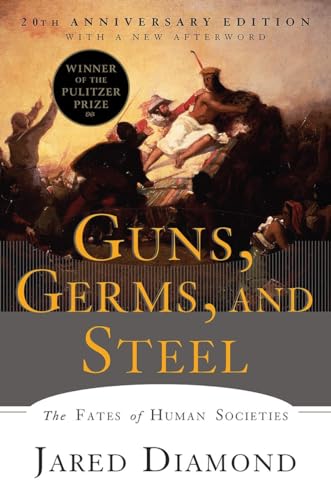Welcome to my review of Guns, Germs, and Steel by Jared Diamond. This book is like a world tour, but instead of postcards, you get a deep dive into human history! Buckle up as we explore how geography, agriculture, germs, and technology shaped our world. Let’s dig in, shall we?
Book Review: Guns, Germs, and Steel
In a nutshell
Guns, Germs, and Steel is a non-fiction book by Jared Diamond. It falls under the category of history and socioeconomics. The book explores big themes like geography, agriculture, germs, and technology. How did these factors shape human history? Diamond asks why some societies advanced quickly while others didn’t. Spoiler alert: it’s not about who had the biggest brains; it’s about who had the best crops and the deadliest germs!
Diamond’s writing is both informative and engaging, making complex topics easy to understand. He uses lots of examples and stories to keep you hooked. One minute you’re in ancient Mesopotamia, and the next, you’re trekking through the jungles of New Guinea. It’s like a thrilling history class but without the boring lectures.
Geographic Determinism in Guns, Germs, and Steel
Let me tell you about a book that changed my view about history – Jared Diamond’s Guns, Germs, and Steel. This book explores the idea of geographic determinism. It argues that geography had a huge role in shaping the world as we know it. It’s like winning the lottery, but with land and resources!
Diamond’s main argument is simple: where you live affects what you have. For instance, Eurasia had a head start because it had the best crops and animals to domesticate. These led to more food and thus more people. More people meant more chances to invent and come up with cool stuff, like guns and steel. Oh, and germs too! Not so cool, but very effective.
Now, imagine trying to start a farm in the middle of the Sahara. Not happening, right? The Sahara didn’t gift its people with easy-to-grow wheat or cows. It gave them sand. Lots and lots of sand. This difference in geography led to different paths of development.
Geographic determinism in Guns, Germs, and Steel also explains why some societies advanced faster than others. The Fertile Crescent had fertile land and a good climate. Polynesia, though beautiful, didn’t have the same advantages. No wonder it took longer to develop similar technologies!
But hey, Diamond doesn’t say geography is everything. He admits other factors played a role too. Yet, it’s hard to ignore how big of a deal geography was in shaping the fate of civilizations. Makes me thankful I can just buy food at the store.
Next up, let’s dig into how agriculture impacted societies. It’s a real game-changer!
The Impact of Agriculture: A Game-Changer in Human History
When I picked up Jared Diamond’s Guns, Germs, and Steel, I wasn’t ready for my mind to be blown. But there it went! Agriculture, man, it changed everything! Before folks started planting crops, human societies were hunter-gatherers, always on the move like me trying to find a good Wi-Fi connection. But once they figured out farming, it was like hitting the jackpot!
Diamond really nails down how agriculture led to stable food sources. This meant people could settle down, form villages, and then cities. And let me tell you, those extra calories from crops helped grow the population faster than my to-do list. It also led to food surpluses, which meant not everyone had to farm anymore. Hello, artisans and soldiers! Specialized jobs were born, and with them came new technology and ideas.
Speaking of technology, Diamond emphasizes how farming communities could develop tools and, you guessed it, weapons. Ever thought about how a plow evolved into a sword? Me neither, but it makes sense! This shift in lifestyle and technology allowed certain societies to conquer others. But here’s the kicker: agriculture didn’t just bring plows and swords. It brought germs too. Farming communities lived close to their animals, which wasn’t as cute as it sounds. It led to deadly diseases that wiped out millions.
So, while agriculture was a game-changer, it had its downsides and upsides. It’s like eating a whole pizza by yourself: great at first, but you might regret it later.
Up next, let’s unravel the tangled web of germs and diseases, and boy, you’ll want to grab a hand sanitizer for this one!
The Role of Germs and Diseases in Human History
So, germs and diseases: not exactly the party guests you want to invite to your next shindig, right? In ‘Guns, Germs, and Steel,’ Jared Diamond shows how these microscopic troublemakers shaped civilizations. These little critters got their VIP passes early, hitching rides with domesticated animals and loved spreading at social gatherings. Picture an ancient rave but with more sneezes and less dubstep.
Diamond uses history to show that societies with close animal-human relationships had a greater chance of spreading infectious diseases. You’d think this would be a major downer, but it did give them an edge, albeit a gross one. When European explorers hit the New World, their germs did more damage than their swords. It’s like turning up to a paintball game armed with a bazooka. Whoa! Talk about overkill, huh?
Besides, those germs didn’t care about social customs. They didn’t need a fancy invite; they just gatecrashed and wrecked the place. Smallpox, measles, and the like took down societies faster than you can say, ‘Bless you.’ Diamond shows how this unplanned biological warfare shaped power dynamics and led to some civilizations becoming more dominant.
Now, not all is rosy in Diamond’s germ theory. Critics argue he may have overstated their impact, but hey, that’s academic bickering. For us readers, it makes one heck of a story. It’s like reading the gritty backstory of your favorite villain – germs weren’t evil, just really, really effective.
Next up, we’ll delve into some shiny stuff: technological advancements that’ll make you want to trade in your smartphone for a spear! Stay tuned.
Technological Advancements and Human History in ‘Guns, Germs, and Steel’
Let’s talk tech! Not the kind that makes you scroll aimlessly on your phone, but the kind that changed the world. In ‘Guns, Germs, and Steel’ by Jared Diamond, the impact of technological advancements is examined in a way that makes you wonder how humanity made it this far without Google Maps.
Diamond argues that societies with the resources and geographical luck to invent and adopt new technologies got a major leg up. Think of steel – not just as a material for swords and armor, but also for plows and tools that revolutionized farming and warfare. In ancient times, having steel was the equivalent of having Wi-Fi and unlimited data today. Everyone wanted it. Few had it.
Now, here’s a kicker: the book highlights how some cultures advanced quicker because they were better positioned to exchange ideas and innovations. Imagine a huge tech convention where everyone gets the latest gadget. But this convention took place over centuries and across continents.
One funny anecdote from my life – I tried to learn blacksmithing once. Let’s just say, I ended up with a lump of metal that looked more like a potato than a knife. It made me appreciate the craftsmanship and knowledge transfer that ‘Guns, Germs, and Steel’ talks about even more.
In a nutshell, Diamond shows technologies weren’t just cool toys; they shaped empires and destinies. Would I recommend this book? Absolutely. It’s like a historical thriller with a nerdy twist. You’ll learn something, laugh a bit, and come out feeling smarter. What more could you ask for?
Conclusion
Alright folks, that’s my review of ‘Guns, Germs, and Steel’ by Jared Diamond. This book takes you through the twists and turns of human history, all thanks to geography, agriculture, germs, and technology. Diamond’s storytelling is engaging, though sometimes a bit dense. Pros: it’s informative, detailed and thought-provoking. Cons: it can feel like a textbook at times. Overall, I recommend it if you’re curious about why the world is the way it is. Just be ready to take some notes!


